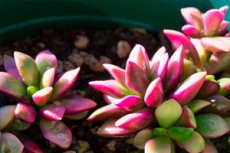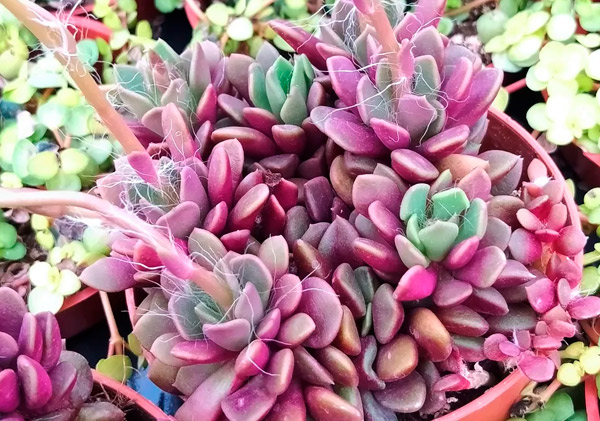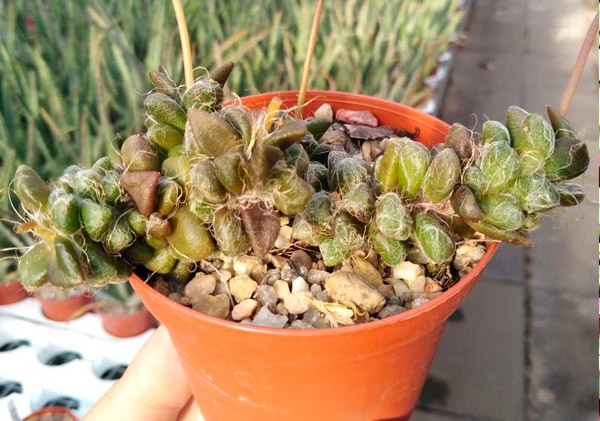New publications
Plants
Anacampseros
Last reviewed: 11.03.2025

Anacampseros is a genus of succulent plants belonging to the Crassulaceae family. This miniature plant attracts attention due to its compact shape and vibrant decorative leaves. Anacampseros has fleshy, juicy leaves that can be green, red, or purple, depending on the growing conditions. In nature, plants of this genus are found in the arid regions of Southern Africa, but due to their hardiness and ornamental appeal, they are widely used in indoor horticulture around the world.
Anacampseros grows slowly and is ideal for growing in containers, pots, and as ground cover. This succulent plant prefers moderate care, making it an excellent choice for both beginners and experienced gardeners.
Etymology
The genus name Anacampseros comes from the Greek words "ana" (up) and "kampter" (curved, bent), which may refer to the curved stems and leaves of some species. The name could also reference the plant's unusual growth form, which gives it an elegant and decorative appearance. The genus Anacampseros was first described in 1794 and has since become popular among houseplant enthusiasts.
Life form
Anacampseros is a low-growing plant with fleshy leaves, often forming compact rosettes. The leaves can vary in shape from round to elongated, with a characteristic dense texture resembling leather, which helps the plant retain moisture. In nature, Anacampseros grows in dry conditions, so its life form is perfectly adapted to dry climates.
Succulents of this genus form spreading or cascading plants, making them excellent for use as ground cover. They can be grown in containers, where their rosette-like or cascading stems create an attractive look.
Family
Anacampseros belongs to the Crassulaceae family, which includes many succulents such as the well-known Crassula (Jade plant) and Sedum. The family is characterized by the presence of fleshy parts that store water, allowing the plants to survive in dry and hot climates. Many members of this family are well-adapted to arid regions, making them popular for indoor cultivation.
Members of the Crassulaceae family can vary widely in appearance — from low-growing plants like Anacampseros to large shrubs and trees. It's important to note that plants in this family are typically resistant to diseases and pests, making them easier to grow.
Botanical characteristics
Anacampseros is a low-growing succulent with juicy, fleshy leaves. The leaves can be various shades of green, red, or purple, making it an attractive decorative element in rooms and gardens. The stems of Anacampseros can be erect or spreading, and over time, the plants form dense colonies that can cover the ground, creating a decorative ground cover.
The flowers of Anacampseros are quite small and have no distinct fragrance, but they can be brightly colored, such as pink, purple, or yellow. The flowers are gathered in clusters, adding to the plant's ornamental appeal during the blooming period.
Chemical composition
Like most succulents, Anacampseros contains chemicals that help the plant retain moisture and cope with dry conditions. The water content in the plant's tissues makes it valuable in studying succulent metabolism. However, scientific studies do not confirm the presence of toxic or poisonous substances in Anacampseros. This plant is safe for people and pets, making it ideal for indoor cultivation.
Origin
The Anacampseros genus is widespread in Southern Africa, where it grows in arid, rocky, and semi-arid areas. Due to its origin, the plants are adapted to harsh conditions and can survive in environments with minimal water. In Southern Africa, Anacampseros is found on sunny slopes and rocky hills, where it forms dense mats that help the plants protect themselves from heat and drought.
Today, Anacampseros is widely cultivated as a houseplant around the world due to its ornamental value and low maintenance requirements. It has become popular not only among gardeners but also in landscape design, where it is used as a ground cover plant.
Ease of cultivation
Anacampseros is one of the easiest plants to care for, making it an excellent choice for beginner gardeners. It does not require complicated care, and it is enough to follow basic succulent growing principles, such as moderate watering, good lighting, and the right soil choice. The plant adapts well to indoor conditions and does not require frequent repotting.
Additionally, Anacampseros is easy to propagate, allowing for quick expansion of your collection or to give the plant as a gift. Since it is not prone to most diseases and pests, this plant is ideal for those looking for a low-maintenance, resilient decorative element for their home.
Species and varieties
There are several species of Anacampseros, with Anacampseros rufescens being the most popular. This species is characterized by vibrant red or purple leaves, giving the plant a particularly decorative look. Other varieties with greener leaves and pink hues include Anacampseros tetragona and Anacampseros subnuda. All species of Anacampseros have similar characteristics but may differ in leaf color and shape.

Anacampseros rufescens

Anacampseros subnuda
Plants of different species and varieties of Anacampseros can be used for various purposes in landscape design, such as ground cover or decorative elements for rock gardens and container compositions.
Size
Anacampseros is a compact plant that rarely grows taller than 15-20 cm. Its stems can be short and spreading or erect, depending on the growing conditions. The plant can spread up to 30 cm or more, forming dense mats or carpets. Therefore, Anacampseros is suitable for compact containers and does not require a lot of space to grow.
Considering its small height and width, Anacampseros can be grown in small pots or even decorative vases, making it an excellent choice for balconies, windowsills, and small garden areas.
Growth rate
Anacampseros is a slow-growing plant. It typically increases by only a few centimeters in height per year, forming dense mats. This makes it an excellent option for those who do not want to constantly monitor fast-growing plants. However, under optimal conditions (proper light, temperature, and watering), Anacampseros will steadily grow and continue to delight with its beautiful appearance.
Lifespan
Anacampseros is a perennial plant that can live for many years with proper care. Its lifespan can be quite long, especially if grown indoors and protected from external adverse factors. With good conditions, such as moderate watering, sufficient lighting, and protection from extreme temperature fluctuations, Anacampseros can delight its owners for 5-10 years or more.
Temperature
Anacampseros prefers moderate temperatures, ranging from 15°C to 25°C. This succulent plant cannot tolerate severe frost, so it should be protected from cold drafts and low temperatures in the winter. At temperatures below 10°C, the plant’s growth slows down, and it may start shedding leaves. During the warm summer months, Anacampseros handles higher temperatures well but should be protected from overheating in direct sunlight.
Humidity
Anacampseros is a succulent well-adapted to dry conditions. It does not require high humidity and prefers dry environments. The ideal humidity for this plant is between 40-60%. Excess moisture can lead to root rot and other problems. Therefore, to successfully grow Anacampseros, it is important to maintain moderate humidity and avoid frequent watering.
Lighting and placement
Anacampseros prefers bright but indirect light. It is ideal for placement on windowsills where it can receive sufficient sunlight but is not exposed to harsh direct rays during the summer. Direct sunlight can cause leaf burn, especially if the plant has been in a shaded area for a long time.
The plant can be placed in a pot on a table, shelf, or in a hanging container, where it will thrive in bright but not overly intense light.
Soil and substrate
For growing Anacampseros, it is recommended to use a light, well-drained soil mix. A good option is a mix for succulents and cacti, which can be made independently. The composition should be: 2 parts leaf mold, 1 part peat, 1 part sand, and 1 part perlite. This will ensure necessary air permeability and prevent water stagnation, which is critical for succulents to avoid root rot. The soil should be slightly acidic or neutral, with a pH range of 5.5–6.5, which is suitable for most succulents.
It is also important to ensure good drainage. A layer of expanded clay, gravel, or small stones should be placed at the bottom of the pot to allow water to drain freely, preventing moisture stagnation at the roots.
Watering
Watering Anacampseros should be moderate and infrequent. Succulents of this genus do not like excessive moisture, and too much water can lead to root rot. During the active growth period in summer, watering can be done about once a week, while in winter, when the plant is in dormancy, it only needs watering once a month. It is essential to let the substrate dry completely between waterings.
For watering, use water at room temperature, preferably rainwater or water that has been left to stand. Water should be poured along the edges of the pot, avoiding contact with the leaves to prevent the development of fungi and rot.
Fertilization and feeding
Anacampseros does not require frequent fertilization, but with proper care, it can be fed from spring to autumn. Use fertilizers for cacti and succulents with low nitrogen content. Fertilizer can be applied once a month by dissolving it in the watering water. In winter, when the plant is in dormancy, fertilizing is stopped.
Organic fertilizers, such as compost or humus, as well as mineral fertilizers, like complex fertilizers for succulents, can be used. It is important to follow the instructions on the packaging to avoid over-fertilizing and harming the plant’s roots.
Propagation
Anacampseros can be propagated by seeds and vegetatively. For seed propagation, choose high-quality seeds that can be sown in a light, loose substrate. The seeds should be sown on the surface of the soil without covering them and should be kept in high humidity. Germination can take several weeks, depending on the conditions.
Vegetative propagation occurs by rooting cuttings. A healthy stem or leaf is cut, left to dry for a few days to prevent rotting, and then rooted in sand or perlite. Rooting usually takes 2–4 weeks. Young plants are transplanted into a permanent pot once the roots are well established.
Flowering
Anacampseros flowers in the warm season, usually from spring to autumn. The flowers are small with a delicate fragrance, and they can be pink, purple, or yellow depending on the variety. The flowers are gathered in small clusters, which are not very conspicuous but add to the plant’s overall ornamental appeal.
However, it is important to note that Anacampseros rarely flowers in indoor conditions. To stimulate flowering, the plant needs bright but diffused light and moderate watering.
Seasonal features
Anacampseros is a succulent, and its growth depends directly on the time of year. From spring to autumn, the plant grows actively, storing moisture in its leaves. In winter, Anacampseros slows down its growth and enters dormancy. During this period, it is important to reduce watering and stop fertilizing.
Summer warmth and sunlight encourage the most intense growth and help maintain the plant’s compact form. In winter, the plant should be placed in a cool room to support its natural biorhythms and prevent excessive growth.
Care features
Anacampseros is easy to care for but requires attention to a few key aspects. First, watering should be carefully monitored to avoid over-watering the soil, and damaged or dried leaves should be removed regularly. The plant prefers dry air, so it does not need frequent misting, which could lead to rot.
Additionally, Anacampseros does not tolerate temperature fluctuations and drafts, so it should not be placed in areas where temperatures change sharply.
Indoor care
Anacampseros thrives indoors as long as a few important conditions are met. First, provide the plant with bright but diffused light. The best places are windowsills, but care should be taken to avoid direct sunlight on the leaves on hot summer days.
Watering should only be done when the soil has dried to a depth of 2–3 cm. In winter, watering should be reduced to prevent excess moisture in the soil. It is also essential to monitor the room temperature to avoid overheating or cold drafts.
Transplanting
Anacampseros should be repotted as it grows, about every 2–3 years. Choose a pot that is slightly larger than the previous one to allow the roots to have room to develop. It is best to use plastic or ceramic pots with drainage holes. The pot should not be too large, as excess soil can hold moisture and cause root rot.
Repot the plant during its active growth period—either in spring or summer. The repotting process includes gently removing the plant from its old pot, removing the old soil, and transferring it to a new pot with prepared drainage and fresh substrate.
Pruning and shaping
Anacampseros does not require regular pruning, but you can trim the stems to form a compact shape if necessary. Avoid heavy pruning, as this can slow down the plant’s growth. If you want to prevent the plant from becoming leggy, you can periodically trim the tops of the young shoots. This will help maintain its compactness.
Potential problems and solutions
Anacampseros can encounter several issues with improper care. One of the main problems is root rot, which occurs due to excessive watering or water stagnation in the pot. To solve this issue, the plant should be repotted into fresh, well-drained substrate, and watering should be reduced.
Another common problem is yellowing or dropping leaves, which may be caused by insufficient light or low temperatures. The solution is to move the plant to a brighter location and avoid cold drafts.
Pests
Anacampseros can be attacked by mealybugs and spider mites. To prevent infestations, regularly inspect the plant and treat it with an insecticide designed for succulents when necessary. It is also useful to periodically wipe the leaves with a damp cloth to prevent dust buildup.
Air purification
Like many succulents, Anacampseros is capable of purifying the air indoors. It absorbs carbon dioxide and releases oxygen, improving the indoor climate. This makes it an excellent choice for use as a decorative plant in homes and offices.
Safety
Anacampseros is safe for humans and pets. It is not toxic, so it can be safely kept in homes with children and pets. The plant also does not cause allergic reactions, making it a good choice for people sensitive to plants.
Wintering
In winter, Anacampseros enters dormancy. During this time, it should be kept in a cool place with temperatures between 12–15°C. Watering should be minimized, and lighting should be reduced to allow the plant to conserve energy for the next growth season.
Beneficial properties
Like other succulents, Anacampseros has several beneficial properties, especially in terms of improving the indoor microclimate. The plant actively humidifies the air, making it particularly useful in homes with dry air. Its presence can help reduce dust levels in a room, improving overall health, especially in the winter when heating can dry out the air.
Moreover, Anacampseros has the ability to absorb carbon dioxide and release oxygen, improving indoor air quality. This makes it a great choice for offices and living rooms, where plants contribute to a healthier atmosphere for work and relaxation.
Use in traditional medicine or folk recipes
Currently, Anacampseros has no widespread use in traditional medicine or folk recipes. However, its beneficial qualities for improving air quality and its decorative features make it valuable for creating a favorable environment. The plant may also be useful as a natural humidifier, protecting against dry air that can irritate the respiratory system or skin.
The absence of toxic properties also makes Anacampseros safe for pets and people, which can be helpful in households with allergy sufferers or individuals with respiratory conditions.
Use in landscaping
Anacampseros is an excellent plant for use in landscaping, especially indoors. Its compact shape and beautiful appearance make it ideal for greening office and residential spaces. The plant looks great in decorative pots, containers, and hanging compositions, making it versatile for different interior styles.
Additionally, Anacampseros can serve as a bright accent in succulent gardens or even as a part of vertical greening. In pots or containers, it is well-suited for creating green corners in offices, restaurants, hotels, and other public spaces where a comfortable and pleasant atmosphere is needed.
Compatibility with other plants
Anacampseros pairs well with other succulents and cacti, particularly in compositions with plants that do not require frequent watering. It will make a good companion for plants such as Echeveria, Sedum, or Aloe, as all of these require similar care: they do not like frequent watering and prefer dry air.
However, Anacampseros should not be placed near plants that require high humidity or frequent watering, as this can lead to root rot. It is best to select companions that thrive in similar conditions to ensure the health of all plants in the same container.
Conclusion
Anacampseros is an easy-to-care-for and decorative plant that is ideal for home and office environments. Its simplicity in maintenance, compact size, and ability to improve the atmosphere in a room make it a perfect choice for people who want to add greenery to their interior. Moreover, the plant does not require special care and thrives in conditions of moderate watering and sunlight. Taking all these factors into account, Anacampseros will be an excellent addition to any interior, bringing both benefits and joy to its owners.
